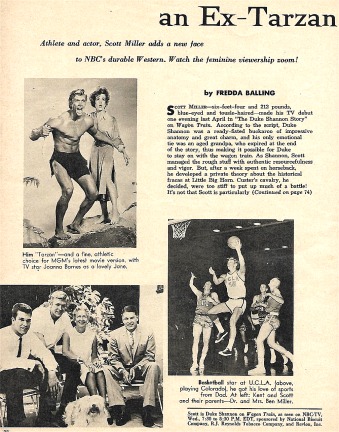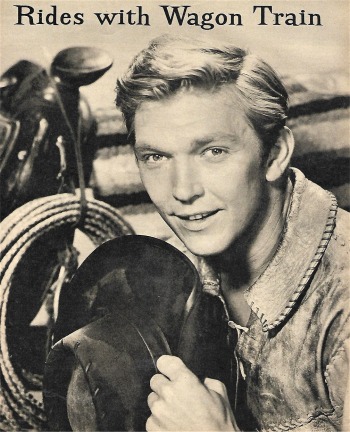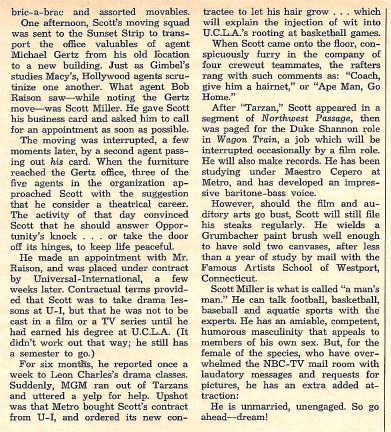
Official Edgar Rice Burroughs Tribute Site
Since 1996 ~ Over 15,000 Webpages and Webzines in Archive
Volume 7538
DENNY ON THE WAGON TRAIN TRAIL
TV Radio Mirror ~ September 1961
From the John Martin Collection





After Denny Miller had starred in 1959's "Tarzan the Ape Man," he began showing up with parts in other movies and TV shows, which led to him becoming a regular on "Wagon Train" in 1961.
He was billed as "Scott Miller" instead of Denny Miller because someone thought that Scott was more of a cowboy name. After "Wagon Train," though, Denny went back to being Denny.
The fan magazine, "TV Radio Mirror," promoted its September 1961 issue with Mr. Miler's name on the cover and there was a four-page article inside, with images of the four pages shown with this post.
The article, headlined "An Ex-Tarzan Rides with Wagon Train," was written by Fredda Balling. The text follows: ~ (John Martin)
...
Scott Miller -- six-feet-four-- and 212 pounds, blue-eyed and tousle-haired--made his TV debut one evening last April in "The Duke Shannon Story" on Wagon Train. According to the script, Duke Shannon was a ready-fisted buckaroo of impressive anatomy and great charm, and his only emotional tie was an aged grandpa, who expired at the end of the story, thus making it possible for Duke to stay on with the wagon train. As Shannon, Scott managed the rough stuff with authentic resourcefulness and vigor. But, after a week spent on horseback, he developed a private theory about the historical fracas at Little Big Horn. Custer's cavalry, he decided, were too stiff to put up much of a battle! It's not that Scott is particularly bitter about the horse, as such. It's just that he has always had trouble with mankind's various means of transportation.It all started when, as a senior in University High School in Los Angeles, he made his initial theatrical appearance. As an act in a school comedy revue, he stormed onstage in red flannel long-johns, pedaling a tricycle and bouncing a yo-yo. At stage center, the yo-yo backfired, striking him briskly on the forehead -- and at that instant, the tricycle bucked, unseating its crimson rider. There wasn't a dry eye in the house. Scott laughed as heartily as anyone else ... which says something for his sense of humor.
No laughing matter was an automotive mix-up one rainy night, on Highway 101. Scott and his date were coming home from a party. Driving slowly through a wind-driven storm, Scott pulled into the left-turn lane behind four other cars that were also preparing to take the Santa Monica Canyon road. A drunk roared into Scott's car from the rear, billiarding it into the next with so much force that, in seconds, six cars were welded together.
Scott blacked out, but regained consciousness an instant later, rain pelting his face. He was still strapped in his seat--but the seat had been torn free of its moorings, and was lying in the back of the car, parallel to the pavement. The entire front of the car was a volcano of flame, hissing and crackling in the downpour.
Fighting another flood of unconsciousness, Scott gulped in breath. He realized vaguely that his passenger had been thrown clear of the car and was lying at the side of the highway. Unbuckling his seat belt, he clawed his way out of the car and stumbled to the girl. Scott drew her carefully onto a blanket, brought from another of the smashed cars, and pulled the girl to safety.
In describing that night, Scott ended the story with the thoughtful statement, "The girl suffered a whiplash injury. She had to wear an iron collar for weeks, but her face was unharmed except for a little scratch above her right eye. I'll tell you, I was glad about that. She's a model and really beautiful."
He dismisses his own cuts, bruises, abrasions--and the car, burned to a cinder--with a shrug...which tells something of his innate concern for others, and his lack of preoccupation with himself.Somewhat later in his career, having completed his two-year Army hitch in Germany, Scott continued his combat with the vehicular system. He made use of his terminal leave by visiting the island of Majorea for a month. And like most tourists--particularly those in Army fatigues who have been foot-bound--he rented a motor scooter for exploration purposes.
The day before he was scheduled to return to camp, he was buzzing up one of the island's single-track, snake-back roads when he caught sight of a bus coming down, out of control. Scott unloaded. He did a one-and-a-half gainer with full twist--into a grassy ditch--while the scooter demolished itself against a stone wall. The bus poured past, shrieking with delight and no brakes.
Adjusting matters with the owner of the motor scooter (i.e.,raising funds to pay for it) kept Scott on Majorea three days beyond his leave. But he was able to explain his absence to the satisfaction of his superiors . . .which tells something of his gift of gab.
In addition to the above bouts with standard means of transportation, Scott has suffered from certain exotic types of locomotion. During the shooting of his "Tarzan" film at MGM he was required to leap from the bank of a Culver City jungle stream onto the back of a dozing crocodile.
Scott made a perfect two-point landing, but the croc did a teeter-board; his tail submerged and his snout swung skyward, unloading Tarzan. The crew gave Scott a ringing cheer for speed in leaving the lagoon. Afterward, he learned that the croc was rubber, but that it had atrophied from lack of use.
Scott also came to appreciate the heavy clothing worn by most elephant riders. Jouncing along on the back of an elephant is roughly equivalent to mounting a cactus. Those elephant-hide hairs, appearing so innocent at a distance, have a coarse rigidity that only a razor commercial could love. Scott says solemnly, "I never believed in the sleeping comfort of a bed of nails until I'd ridden an elephant."
How did this ardent admirer of the art of walking make the long trip to Hollywood and television? Scott was born Dennis Linn Miller in Bloomington, Indiana . (The "Dennis" was changed to "Scott" by his first contracting studio. He says of the alternation, "An actor by any other name smells the same.")
He was the first of the sons of Dr. and Mrs. Ben Miller. At the time of Scott's birth, his father was chairman of the Department of Physical Education at the University of Indiana. Thereafter, the family lived in Silver Springs, Maryland, where Dr. Miller served as executive secretary for a national youth organization, and on Long Island, where he was director for American Youth Hostels. The next move was to Los Angeles, when Dr. Miller became chairman of the Physical Education board for UCLA.
At fourteen, Scott entered the sixteen-year-old competitive class for the National School Boy Golf Tournament--and won. At seventeen, he spent a summer serving as life guard and deck boy for the Freeport Yacht Club. And that fall--at California's "Uni High" -- he distinguished himself on the basketball court (as well as on the aforementioned tricycle).
At UCLA, Scott majored in Physical Education and was initiated into Phi Gamma Delta social fraternity. To keep in shape--and to support an active dating campaign--he took a series of summer jobs. One was with Bekins Van & storage, a company specializing in big men to handle delicate bric-a-brac and assorted movables.
One afternoon Scott's moving squad was sent to the Sunset Strip to transport the office valuables of agent Michael Gertz from his old location to a new building. Just as Gimbel's studies Macy's, Hollywood scouts scrutinize one another. What agent Bob Raison saw--while noting the Gertz move--was Scott Miller. He gave Scott his business card and asked him to call for an appointment as soon as possible.
The moving was interrupted a few moments later, by a second agent passing out his card. When the furniture reached the Gertz office, three of the five agents in the organization approached Scott with the suggestion that he consider a theatrical career. The activity of that day convinced Scott that he should answer Opportunity's knock . . . or take the door of its hinges, to keep life peaceful.
He made an appointment with Mr. Raison, and was placed under contract by Universal-International, a few weeks later. Contractual terms provided that Scott was to take drama lessons at U-I, but that he was not to be cast in a film or a TV series until he had earned his degree at U.C.L.A. (It didn't work out that way; he still has a semester to go.)
For six months, he reported once a week to Leon Charles's drama classes. Suddenly, MGM ran out of Tarzans and uttered a yelp for help. Upshot was that Metro bought Scott's contract from U-I, and ordered its new contractee to let his hair grow . . .which will explain the injection of wit into U.C.L.A.'s rooting at basketball games.
When Scott came onto the floor, conspiculously furry in the company of more crewcut teammates, the rafters rang with such commands as, "Coach, give him a haircut," or "Ape-Man, Go Home."
After "Tarzan," Scott appeared in a segment of "Northwest Passage," then was paged for the Duke Shannon role in Wagon Train, a job which will be interrupted occasionally by a film role. He will also make records. He has been studying under Maestro Cepero at Metro, and has developed an impressive baritone-bass voice.
However, should the film and auditory arts go bust, Scott will still file his steaks regularly. He wields a Grumbacher paint brush well enough to have sold two canvases, after less than a year of study by mail with the Famous Artists School of Westport, Connecticut.
Scott Miller is what is called "a man's man." He can talk football, basketball, baseball and aquatic sports with the exerts. He has an amiable, competent, humorous masculinity that appeals to members of his own sex. But, for the female of the species, who have overwhelmed the NBC-TV mail with laudatory messages and requests for pictures, he has an extra added attraction:
He is unmarried, unengaged. So go ahead--dream! 


